723rd Railway Operating Battalion
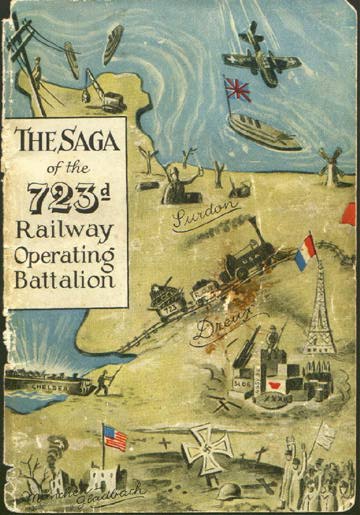
COVER
THE SAGA
of the
723d
Railway
Operating
Battalion
PAGE 1
BLANK
PAGE 2
Where were you on 30 Nov.1943?
On that date General Order No. 174, Headquarters, 8th Service
Command authorized the activation of our unit. Acting under that authority,
Lt. Col. Doyle Gresham, our Commanding Officer, activated the unit at Fort
Sam Houston, Texas, on 21 December, 1943 and we thus became a part of the
Military Railway Service and the Army Transportation Corps. The initial
strength was 21 commissioned officers and 71 enlisted men, the latter having
been sent as a cadre from the 746th Railway Operating Battalion. The first
headquarters was established in building T-1282 located near the intersection
of Garden Avenue and W. W. White Road, and fronted on Garden Avenue (more
picturesque in name than in reality). However, what this location lacked
in scenic beauty was more than compensated for in the proximity of the
life saving restaurant located diagonally across the street. All of the
"old timers" recall the Chapel of the Rock just a few more steps down the
road. During our stay in Fort Sam Houston personnel were billeted in barracks
located north of W. W. White Road, east of Forage and south of Hardee Road.
These were large, two-story, frame structures of the type well known to
every GI who passed through a training center in the States.
On 5 January 1944 the first shipment of enlisted personnel arrived
and were assigned to the various Companies and between the date of activation
and 21 January 1944, a total of 884 enlisted men were assigned to the unit.
98% of these reinforcements came into the Army via the "Selective Service"
route, the other 2% being regular army or volunteers. Thus, we begin the
trip to Berlin as "citizen soldiers".
PAGE 3
BASIC TRAINING
Our eight weeks program of basic military training started on
17 January 1944. To a majority of the men, mostly raw recruits only
recently dispatched from reception centers, the first day of basic training
was a strange and bewildering experience. However, during the initial stages
of basic training the routine schedules, which is the army life, soon narrows
the "experience" down to one of bewilderment only.
The early history of the 723d is conspicuously lacking in anecdotes
and unusual stories concerning the officers and EM. This can be attributed
primarily to the fact that the basic training program was insistently emphasized
during the first few months of the unit's existence.
Aside from the usual classes, drill and technical films,
among the more memorable activities were the several
night marches that were made by the Battalion to provide preliminary experience
in field movements as well as an opportunity to develop physical stamina
among the men. Of course the marches were not complete until a full count
of blisters was made upon return.
The first long march occurred when the move was made to camp
Bullis for the purpose of qualifying in arms. The march took from 0800
on February 13, 1944, to about 1600 the same date, a distance of approximately
20 miles. The most eventful aspect being the adverse weather conditions
under which the movement took place. Intermittent rain and an overcast
sky provided little comfort and when fatigue began to be felt by
the men near the end of the march, these factors served to emphasize their
discomfort. Nor was there much respite when the Battalion strode into Camp
Bullis dispersing by companies into the tent areas assigned to each of
the unit's four companies, for the lush comforts of
Fort Sam were conspicuously lacking.
PAGE 4
HOME ON THE RANGE
Camp Bullis will be remembered for its rocky company streets;
its rugged mess halls; and inconveniently located latrines.
The main purpose of this period was for all men to qualify as
marksmen with the 30 caliber 1903 A-3 rifle. This was accomplished
according to schedule with the highest score of
188 for EM and 178 for officers. Also the training at Camp Bullis included
firing the 30 caliber carbine for familiarization, 30 and 50 caliber machine
guns by part of the unit, anti-aircraft firing, and last but not least
the infiltration course where all members received their baptism of fire.
Machine gun bullets whined overhead and tracers could be seen flashing
through the air along with detonations of dynamite throwing
showers of mud skyward as visible reminders that
the exercise was no pantomime.
By the 27th of February 1944, the Battalion had completed its
program at Camp Bullis and on the same day left for a predetermined
bivouac area approximately six miles northeast of the
Camp.
Along with learning more of the ways and means of soldiers
in the field the Battalion enacted offensive military action against Branntown,
a reconstruction of a war torn village such as might be encountered in
actual operations overseas.
To the satisfaction of inspectors from Fort Sam Houston, our
Commanding officer and company officers, our Basic Training period was
announced "finis". The unit then returned to Camp Bullis
to prepare for the march back to Fort Sam. On the 9th
of March, Companies A, B and Hq shouldered field packs and waved a fond
adieu to Camp Bullis and to C Company which remained behind for two days
awaiting favorable weather conditions which would permit the completion
of anti-aircraft firing with the 50 caliber machine gun.
By the 11th of March 1944, the entire Battalion
was assembled at Fort Sam Houston and the unit boarded trains on the 13th
bound for Lincoln Army Air Field, where mess and quarters were established
during the Technical training period on the Chicago, Burlington and Quincy
Railroad.
PAGE 5
TECHNICAL TRAINING
The 723d Railway Operating Battalion arrived in Lincoln, Nebraska
on March 15, 1944, establishing Headquarters at 1200 hours on that date.
Within the first three days after arrival, furloughs were granted to all
enlisted personnel and officers eligible. A few men had been released for
furloughs before the unit left Texas but this group was in the minority
and it was not until the organization arrived in Lincoln that the majority
of the Battalion personnel set off for home to enjoy the long awaited break
in the monotonous routine of army life.
On the 3rd of April 1944, the Technical Training schedule was
set in motion and each of the four companies set about to learn the specialized
skills necessary in railroad operation. Some of the men were beginners
and their concentration was bent on acquiring the rudiments of hitherto
unknown trades or specialties. To others who had civilian railroad experience,
the training program was an interim in which previously acquired skills
were entranced and perfected under intensive instruction and practice.
Thus the roundhouse, the cupola, the engine, the open track where the maintenance
of way crews worked, the barracks wherein telegraphy was taught and the
stations that dotted the rail lines emanating from the Lincoln Terminal
became class rooms where practical experience, civilian railroaders, and
the officers of the Battalion were the teachers in getting the Unit coordinated
into a working machine to handle all duties pertaining to operating
and maintaining anywhere from 60 to 120 miles of railroad track and equipment.
The training period at Lincoln was not entirely technical, however,
for a program was set up whereby all men were given refresher courses in
basic military subjects, such as: field striping 50 caliber machine guns,
close order drill, calisthenics, Chemical warfare and other training that
helped make a more efficient unit for protecting as well as operating a
railroad.
PAGE 6
On May 4, after arrangements were made to feed the Battalion
at the station compliment mess of Lincoln Army Air Field, the cooks were
placed on detached service at Fort Riley, Kansas to attend the Cooks
and Bakers School.
Under a hot, summer, Kansas sun and over hot stoves our "culinary
commandos" were initiated into the mysteries of Army Cookery.
The curriculum was replete with courses on every phase of cookery
plain and fancy.
The cooks returned to Lincoln, on June 29, with their minds
full of new theories, new recipes and new resolutions that, from that day
hence the food would be better than ever.
There were two additional movements made to Fort Riley. The
first, for the purpose of firing the 50 caliber machine gun on the M 45
anti-aircraft mounts by a required number of the Battalion. This program
covered a period from the 16th to the 23d of May 1944. The second was undertaken
to fulfill training requirements relative to the qualification in arms.
All men who had not qualified with the 03 rifle, and those who had not
previously completed the infiltration course or fired the carbine for familiarization
were required to go to the Fort Riley Range for this purpose. This was
accomplished from the 25th to the 27th of June 1944.
While receiving technical training in Lincoln the 723d rendered
a valuable public service during a flood emergency which occurred in the
early part of June 1944. The flood waters of the Platte River were
particularly rampant and there was, for a time, a serious threat
of washouts on the Burlington Line which spanned the Platte east of Ashland,
Nebraska.
In answer to a call for volunteers for aid, more than one hundred
members of Company A, including company officers, took over the job of
filling and loading sand bags on flat cars for shipment to threatened areas
where the bags were used to buttress the track embankment in high water
areas. Pausing only when the rain reached cloudburst proportions
PAGE 7
the emergency detachment worked under floodlights throughout the night
where in a ten hour period 14000 sand bags were filled and loaded on 23
flat cars.
Also not to be forgotten, was the night problem that was undertaken
on June 2, 1944. This being taken as a secret move under simulated battle
conditions.
Carrying full field packs and wearing steel helmets, the
Battalion marched a distance of approximately ten miles over roads and
terrain lined with concealed dynamite charges which were detonated
at intervals to achieve the effect of hostile artillery fire. To lend additional
realism to the exercise, groups of men were selected to act the part of
enemy opposition firing blank ammunition from machine guns located at several
points.
Twice during the march, gas attacks were simulated and masks
were employed as the Battalion made its way through clouds of smoke and
tear gas released by the "enemy". Contact with advance
columns deployed by the opposition resulted in the enactment of frequent
frontal as well as rear guard action.
And so, back to, and on with technical training which was concluded
with an exercise conducted on the famous Ashland Prague Division. The Battalion
was bivouacked at the National Guard Camp just outside of Ashland, Nebraska
for the duration of the battle simulated conditions which lasted
from the 8th to the 12th of July. The problem being, to run this stretch
of track in the required and typical GI manner.
The Battalion was divided into opposing forces, in this "test
of operation", one charged with getting a supply train through from Ashland
to Prague, while the other did its best to stop or delay the run.
Every effort was made to have the action as realistic as possible and guards
patrolled bridges and other vital points of the line. Long
in advance of the train's progress, the right-of-way was planted
with booby traps and obstructions of all kinds, and at frequent intervals
the train was the center of exploding charges and clouds of gas.
PAGE 8
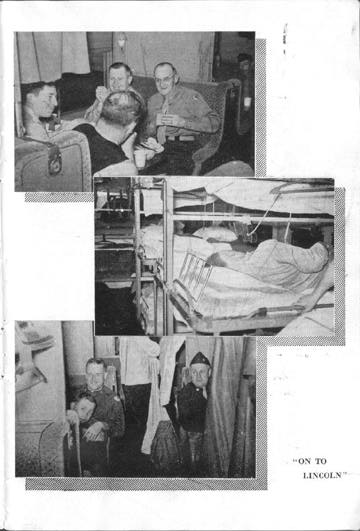
PAGE 9
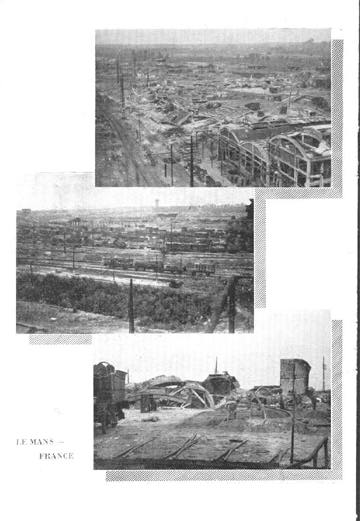
PAGE 10
Learning their specialized jobs as engineers, firemen, brake men,
telegraphers and maintenance of way men on Burlington Lincoln Division
each man got a chance to prove himself a qualified "railroader" on this,
the final exercise of training which combined both technical and military
operations.
With the by word now as, "Aw, this outfit won't go overseas",
the advance party left on the 15th of July 1944 to procure and ready an
array of supplies and equipment required by the overseas assignment
to come.
No one knew the destination of the advance party and few, if
any, would hazard a guess on the point. One thing was certain, however,
the departure of this group, which included the Adjutant, Assistant Battalion
Supply Officer and the Battalion Supply Sergeant, was concrete indication
that very soon the unit would be on the move toward one of the global battlefronts.
In a ceremony at Theater No. 1, LAAF, on July 26, a farewell
gathering was arranged by officials of the Burlington Railroad for the
723rd where all members of the Battalion were presented money belts
by the Burlington Officials.
PAGE 11
THIS IS IT
Still clinging to a saying, which by this time had changed to,
"One thing sure, half of these guys can't pass the overseas physical at
the Port", the Battalion left Lincoln on August 2, 1944.
On August 4, the 723d arrived at Camp Shanks, there to receive
overseas indoctrination lectures, issues of new clothing and last minute
scrutiny of personnel and military records; besides, checking TAT, preparing
rosters and, - What do you know? Everyone passed the overseas physical.
Then came the familiar, "This is it", and on August 10, the
Battalion, by companies, marched to the station and each individual with
full field pack end duffle bag boarded a train for NYPE. On arriving at
3 New York Central station the men loft the train with all equipment and
marched aboard the ferry, crossed to Manhattan, onto the pier and boarded
the E. B. Alexander. With very little delay the ship pulled out of
New York at approximately 1030 hours on August 11, 1944.
Aside from abandon shin drills, inspections sweating out two long chow
lines daily, - usually eating with perspiration dripping into the mess
gear, and an occasional detail in the galley or latrine, the trip was uneventful
and the passenger was on his own. Reading, several boxing matches, movies
and an orchestra organized from among those no board,
provided entertainment during the voyage.
The convoy grew the first few days and dispersed again for several
different ports upon approaching the coast of England.
The E. B. Alexander docked at Liverpool on August 22, and the 723d disembarked
on the morning of the 24th boarded trains immediately and arrived at Southampton
the some day.
With approximately 30 hours spent in England the Battalion boarded
the British ship Chelsea on August 25, at Southampton.
The troop compartments ware more congested and uncomfortable
aboard the Chelsea than they were on the E. B. Alexander and the food served
was no attraction.
PAGE12
The channel crossing was as uneventful as it was slow
for it was not until approximately 1600 hours the 26th that the unloading
was started by L.C.I.'s onto Utah Beach. A baggage detail being left aboard
to unload duffle bags.
After landing on the beach, the Battalion moved inland to bivouac
area eight, some five miles north and east of the landing point.
Encampment here lasted but two days and on August 28, at 2000
hours, the Unit moved via motor convoy to the outskirts of Chef Du Pont.
This time bivouacking in an apple orchard near the railroad that passed
through the village.
The following day at 0600, shelters were struck and the Battalion
entrained at Chef Du Pont headed for Le Mans, France, its first station.
PAGE 13
FULFILLMENT OF A MISSION
Thus across France Via St. Lo, Argentan, Surdon, Alencon and
finally Le Mans, the 723d detrained and moved to quarters in a former French
army barracks just recently evacuated by the German forces.
The Battalion with its mission underway at last, established
Headquarters at 1330 hours 29 August 1944, on the third floor of a building
just north of the depot at Le Mans and operated between Le Mans and Surdon.
This first operation was more in the nature of a temporary assignment under
the 708th Railway Grand Division then located at Pontaubault.
On September 9, the 723d moved to Surdon, France where Battalion
Headquarters was established. The Unit was assigned, on this date, under
the 706th Railway Grand Division at Le Mans, to operate the territory from
Surdon to Dreux including both terminals. Temporary quarters were established
in three French Manors located on the highway connecting Nonant Le Pin
and Marmouille.
When the Battalion arrived in Surdon, there was much to be done.
Most of the buildings had been damaged by air attack. The railroad yards
were in poor condition and there were no facilities for handling other
than a mere trickle of traffic.
The personnel of the Unit was dispersed between Surdon and Dreux
but the bulk of the Battalion was quartered at Surdon.
And now, what had been an enigma of silence was unfolded as
the advance party arrived on September 14, 1944. They had left Lincoln,
Nebraska, we learned, and proceeded to New York where they embarked on
the Mauritania. In five days, sailing without convoy protection they crossed
the Atlantic.
From the day the advance party landed in England their work
began. Equipment ranging from giant prime movers to shovels was gathered
from every corner of England. Ample testimony that the party had performed
its mission thoroughly was evident when the Unit's impedimenta was set
down in
PAGE 14
France. The Battalion was as well equipped to perform its mission as
was any similar unit then operating on the continent.
With the Unit complete once more, several projects were initiated
to improve Surdon. German Prisoners were obtained from Alencon and the
"face lifting" began.
Work was started immediately to clean out and repair the station
and the few buildings that were not completely rendered useless by the
sledge of war. The remainder were leveled and the surrounding areas cleared.
The station was used as dispatcher's office, Battalion Headquarters
and sleeping quarters for transient crews as well as for Battalion Headquarters
personnel.
Several smaller buildings were used for a Post Exchange, Chaplain's
office and for the power unit which furnished electricity.
Five German, Pre-fabricated barracks were dismantled and moved
from Nonaut Le Pin to Surdon where they were reconstructed on the site
where a short time before had stood bomb gutted buildings. One was
used for officers quarters, another for a dispensary, as a medical detachment
of two officers and nine enlisted men finally arrived and was assigned
to the unit on October 13, 1944. A third was used for enlisted men's quarters.
Still under construction when the unit left Surdon were two
other barracks, one scheduled to be used as a mess hall and the other as
enlisted personnel barracks.
Facilities for coaling engines were provided and water lines
were reconstructed to bring water into stand pipes for servicing locomotives.
A stockade and barracks were built to house 250 German prisoners
who were assigned as a permanent labor corps for the Battalion. The prisoners
were utilized to the utmost in all of the rehabilitation work and even
on the railroad, where security permitted.
Tracks and yard facilities were repaired and pressed into service
to handle the rush of traffic that began to pour out
PAGE 15
of Cherbourg and through Surdon on the way to Paris and the combat
areas beyond.
Concurrent with the rebuilding of Surdon the train movement
and operating sections of the Unit kept supply trains moving. Company C
personnel worked day and night many of its crews going twenty four and
thirty six hours without respite. The dispatchers and operators too, were
occupied around the clock moving an endless stream of cars eastward to
Dreux.
So great, as a matter of fact, was the volume of traffic between
these points that the operating crews were worked to a point almost beyond
human endurance. The 710th Railway Grand Division, to whom we were now
assigned under date of September 18, was aware of this situation, however,
and on October 6, 1944 a radiogram was issued from their Headquarters attaching
two officers and 127 enlisted men of the operating company of the
732d Railway Operating Battalion, to Company C of this unit. This platoon
arriving on the 14th of October, provided enough manpower to give relief
to the train and engine crews and they remained until October 21, at which
time they returned to their parent organization.
On October 25, 1944 Headquarters of the 723d was closed at Surdon
and re-established on the same day at Dreux, France. The Unit being assigned
the additional trackage west of Surdon to Argentan. This increase of divisional
territory made the overall distance now covered, 112 kilometers or 70.4
miles.
The situation by now permitted the hire of French civilians
as parts of crews and laborers in many jobs around the roundhouse and yards.
The German Prisoner Company had been moved to Dreux and was still used
to very good advantage.
The outside interests during November included a memorial service
and parade on Armistice Day when the Battalion was invited by the City
of Dreux to participate in the activities of the day. There was a
gathering of the towns people in the main square where the parade was formed.
This Unit being represented by officers, color bearers and
PAGE 16
guards, the Drum and Bugle Corps and a detachment of enlisted men armed
with rifles. The parade proceeded from the center of town to the cemetery
where our men held services by the graves of American aviators killed near
Dreux prior to American occupation. A very fine speech was made by the
Major of Dreux in honor of all war dead.
Thanksgiving was duly observed by the Battalion on November
23, at a gathering where all members that could possibly be spared without
hampering operations, attended. Also attending the ceremony were
several officers from higher headquarters and the City Council of Dreux.
With music and singing, the President's Thanksgiving Proclamation read
by the Commanding Officer, a word from the Mayor and a brief message by
the Unit Chaplain, the program was completed with the award of Good Conduct
Ribbons to 168 enlisted men by their respective Company Commanders.
The stage was appropriately decorated for the occasion
with fruits, vegetables and other merchandise. This, in addition to the
free will offering, taken at the close of the ceremony amounting to approximately
3500 francs, was distributed to the poor and needy of Dreux and vicinity.
In the evening a dance was held, which incidentally, was the
first public dance to be held in Dreux for approximately four years. The
Dance was enjoyed by all military personnel of the area and by the civilians
who cared to attend.
On 9 November 1944 when changes were made in Grand Division
Territories the 723d was now under the 707th Railway Grand Division located
at Cherbourg. The usual headaches were encountered that always occur when
such changes are made. However, the Battalion's territory was not changed
again until December 23rd when the line was again extended and the Battalion
was bounced back to the 710th Railway Grand Division. This time the addition
was made east of Dreux to St. Cyr and including Matelots Yard at Versailles,
making a total of 110.7 miles of the main rail supply line to the "Front",
operated by the Unit.
With what turned out ho be the final major offensive action
by the German War Machine the Battalion was put on the
PAGE 17
alert and Christmas and New Years passed with very little celebration.
The spirit of Christmas was upheld, however, when at a suggestion
from Battalion Headquarters and with the aid of the chaplain, the following
program was carried out:
22 December - The Chaplain, with a group of officers and enlisted
men, visited the schools extending greetings from the American Army. More
than 2500 candy bars, donated by the men from their Christmas boxes and
Post Exchange rations, were distributed to the children. Songs and Christmas
exercises were presented by the children at each school.
23 December - The Chaplain visited the children's hospital and
distributed several hundred candy bars, apples, and toys.
25 December - About 230 French orphans, and children from very
poor families, were fed a Christmas dinner in several mess hells. Candy
and toys were distributed after the meal. In the afternoon a movie of the
American armed forces in action was shown to 1500 French children. With
the explanation and hope that their Christmas was brighter and happier
because of the Allied Liberation of France.
When advised of the bombing of St. Lazare Station in Paris on
the night of December 26, a small detail from the Unit was sent to help
repair the damage. Two of this group received commendations for their efficient
work from the Superintendent of Equipment of the 710th Railway Grand Division
and from their own Commanding Officer.
Several other commendations were received from higher headquarters
while the Unit was at Dreux. One of the more notable being made for the
efficient handling and safety record that was established during the Battalion's
operations on the continent.
Only one major accident occurred in this period An ammunition
train collided with a wrecking derrick overturning the engine and tender,
killing a French fireman and setting fire to the ammunition cars. However,
twenty of the twenty nine cars in the train were saved. As
a result two officers of the Battalion were later awarded Bronze Star Medals
for performing exceptionally hazardous duties in connection with
PAGE 18
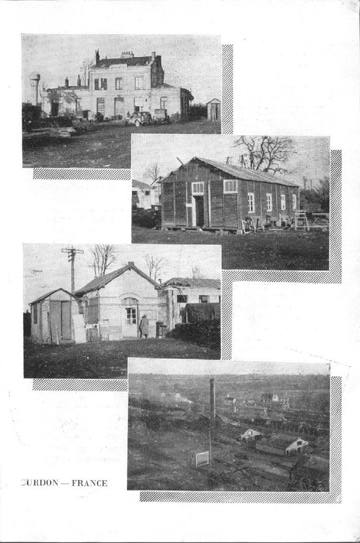
PAGE 19

PAGE 20
saving additional cars and pulling the fire on the engine to prevent
it from exploding. Several other members of the Unit were awarded Meritorious
Service Certificates, by the Director General, Military Railway Service
for their aid in clearing up the wreck.
A voluntary contribution was made by the men of the Battalion to the
widow of the deceased SNCF fireman in the amount of 10,500 francs ($ 210.00).
On the 21st of January the European Theater of Operations
Blood Bank sent out an urgent appeal for type "0" blood. All of the Companies
were checked and of the 355 EM with that type of blood, scattered over
120 miles of railroad, 159 were able to make donations without any loss
of time from work. Five officers of the Battalion also donated blood.
Another project, shortly afterward, was instituted in which
12,244 francs was collected and contributed in the "March of Dimes" drive
conducted in the States in connection with the celebration of the President's
birthday. Altering the customary slogan, the 723d campaign was publicized
as a "March of Dimes Across the Sea" and a money order ($ 246.00) was sent
to the Warm Springs Foundation, in care of the President of the United
States.
The balance of the present assignment was uneventful except
for the gradual change to Phase III Operation, whereby the French took
over the operation of this territory and under Movement Orders from Headquarters
Second Military Railway Service dated l2 March 1945, the Battalion Supplies,
Equipment and personnel left on four trains on March
13th, "Destination Germany"!
Following close on the heels of the advancing American Forces,
the Unit arrived in Munchen-Gladbach at night. Amid the distant rumbling
of Artillery the first train passed through the ghostly terminal unknowingly,
but stopped short a few miles beyond with the nose of the engine in a bomb
crater and the personnel untangling themselves from other arms, legs and
equipment at the front of each car. Only a few suffered bruises and scratches,
however, arid the train was pulled back to the station just at dawn.
PAGE 21
Headquarters was established at Munchen-Gladbach. Germany
on 15 March 1945 at 1200 hours; one year to the day and hour after Headquarters
was established at Lincoln, Nebraska to start training for it's primary
mission. At that time no one dared to predict that the 723d Railway Operating
Battalion would be operating in Germany one year from that date.
With this change in operating territory came the change of technical
supervision from the 710th to the 708th Railway Grand Division. The main
line of operation was from Herzogenrath to Geldern with railheads changing
from time to time to fit the needs of the Ninth U.S. Army, whom we were
now serving on a priority movement basis.
Operations were under shell fire quite often at several
points along the line but no serious damage was caused and no lives lost
from this action. Of course this threat was removed almost overnight when
the Ninth Army broke through the German Rhine defenses and changed the
battle line from within a few miles to a point approximately half way across
Germany.
The untimely death of our President and Commander in Chief was
mourned by all and a memorial service was held on April 14th at the Battalion
Chapel in his honor.
During April an increasing flow of supplies were pushed through
to keep up with the lightening advance of the armies and westward trains
hauled an estimated 125,000 prisoners of war and 29,000 French and Belgium
repatriates in the month period.
The 723d's most important and exacting task was the operation
of the Gouldin Bridge at Wesel - first railroad span constructed across
the Rhine River. Operation of the bridge became the Unit's responsibility
on 26 April, and from then to VE-Day, a daily average of 16 Eastbound trains
crossed the river - or about one train eastward every hour.
The significance of operating the bridge becomes evident on
considering that over a single track span it has been
PAGE 22
necessary to funnel all Eastbound traffic to the American 1st, 9th
and 15th Armies as well as the British 2nd Army. Thus the bridge was, in
effect, a self-imposed bottleneck which, unless expertly tended and controlled,
would have choked off rail traffic destined for supply depots and railheads
supporting the Allied sweep to victory.
It is of prime importance that we not forget the splendid work
done continually by the track, bridge and signal platoons of Company "A".
Their never-ending job of construction, maintenance and rehabilitation
was accomplished under hazardous conditions and in all kinds of weather,
making it possible to speed up operations with good communications
and with an increasingly safer right-of-way.
The accomplishments of the car, shop and roundhouse platoons
of Company "B" are evident as shown in statistics listed at the end of
this narrative.
The 9th of May saw the official end of the war in Europe, thus
our operations were reversed. The flow of certain items, such as
ammunition and ordnance material to the forward areas was halted and a
great movement to the rear was started.
Once again a change in Grand Division jurisdiction was made
and on 17 April the Unit was again under the 707th. Several adjustments
in the Battalion's territory were made from time to time. The major
change involved the assignment of the line from Munchen-Gladbach,
over the Victory Bridge at Duisberg to Hamm, Germany, on 23 May 1945. Also
the the spur lines from Viersen, to Dulken, Germany, and Krefield to Willich,
Germany, were still the responsibility of the 723d.
Several former German railroad employees were hired before the
end of hostilities to help get electrically operated switches and
control towers in the various yards into service and with the end of the
war utilization of all former railroad personnel was started. The ultimate
goal being to turn back all operations to the Germans, having
only supervisional control by the occupying forces.
PAGE 23
With this goal now attained and the supervision of
the railroads turned over to the British in this, their occupational territory,
the 723d has completed it's mission in the ETO.
The Battalion is authorized Battle Stars for campaigns, "Northern
France", "Rhineland" and "Central Europe". The Unit had no casualties from
direct enemy action but there were four deaths from accidents. One officer
lost a hand and one EM lost a foot from mines planted near the right-of-way
at Duisberg. Each accident was as unfortunate as are all accidents but
to be serving under the conditions of modern war, injuries and casualties
have been extremely low in this Unit.
On 3 July 1945 the announcement was made that the Battalion
was classified a Category IV Unit and at some future date, yet to be determined,
would return to the USA for deactivation thus ending the life of a battalion.
Now, with calisthenics, close order drill and special service
programs to pass the time, one question is in the mind of each individual,
"When and where do I go from here?", as no one knows who will remain with
the Unit to go "overseas" (USA) or who will be redeployed in this zone
- only time and Special Orders will tell.
PAGE 24
|
IN MEMORIUM
JOHN R. VALENTINE, JR.
Technician Fifth Grade
Killed in line of duty:
France - 10 December 1944
*
JAMES V. GROSS
Private First Class
Killed in line of duty:
Germany - 31 March 1945
*
WILLIAM G. MILES
Technician Fifth Grade
Killed in line of duty:
*
ARTHUR R. HOVELAND
Private First Class
Died - Germany - 2 June 1945
|
PAGE 25
BATTALION AWARDS
Campaign Star "NORHTERN FRANCE"
Letter, Hq, ETOUSA, file AG 200.6 OpGA; Subject
"Battle Particaption Awards", dated 21 April 1945.
Campaign Star "RHINELAND"
Letter, Hq, ETOUSA, file AG 200.6 OpGA; Subject
"Battle Particaption Awards", dated 6 July 1945.
Campaign Star "CENTRAL EUROPE"
Letter, Hq, ETOUSA, file AG 200.6 OpGA; Subject
"Battle Particaption Awards", dated 27 June 1945.
Campaign Ribbon EAME
WD Circular No. 62, 11 February 1944
INDIVIDUAL AWARDS
Captain ThomasW. McCabe
Purple Heart -
Awarded by GO 52, Hq32d General Hospital, APO 228,
U.S. Army dated 19 June 1945 for wounds recieved
as a
result of enemy action in Germany 10 June 1945.
Bronze Star -
Awarded by GO 100, Hq, Com Z, ETOUSA, 11 June 1945,
for meritorious service in connection with miltary
operations 25 January 1945, in France.
Captain George O. Larmer
Bronze Star -
Awarded by GO 100, Hq, Com Z, ETOUSA, 11 June 1945,
for meritorious service in connection with miltary
operations 25 January 1945, in France.
Pfc Ivan G. Stewart
Purple Heart -
Awarded by GO 52, Hq32d General Hospital, APO 228,
U.S. Army dated 19 June 1945 for wounds recieved
as a
result of enemy action in Germany 10 June 1945.
PAGE 26
CERTIFICATES OF MERIT
| 1st Lt. Harold D. Lurie |
Tec 4 William H. Thompson |
| T/Sgt Joseph E. Kaschuluk |
Tec 5 Ottis R. Brown |
| T/Sgt Raymond H. Smith |
Tec 5 Thomas W. Canty |
| Sgt Franklin J. Carto |
Tec 5 Earl O. Full |
| Sgt Claude E. Palmer |
Pfc John H. Becker |
| Sgt Fred J. Sachs |
Pfc Donald V. Cornia |
| Tec 4 Harry N. Alexander |
Pfc Webb S. Swann |
PAGE 27
"GONE BUT NOT FORGOTTEN"
| RANK |
NAME & POSITION |
ASN |
DATE
ASSIGNED |
DATE
TRANSFERRED |
| 1st Lt |
Blessman, Charles W.
Rd Foreman of Engines |
|
21 Dec 43 |
4 Mar 44 |
| 2d Lt |
Bryan, Gilbert B.
Battalion Supply Officer |
|
21 Dec 43 |
11 Mar 44 |
| 1st Lt |
Crabb, Vernon R.
Chief Dispatcher |
|
21 Dec 43 |
4 Mar 44 |
| 1st Lt |
Curley, Leo C.
Asst Trainmaster |
|
27 mAY 44 |
16 JUL 45 |
| 2d Lt |
Davis, Sidney T.
Asst Trainmaster |
|
16 Feb 44 |
8 Jul 44 |
| 1st Lt |
Gregory, Carlos F.
Yardmaster |
|
21 Dec 43 |
5 Jun 45 |
| Capt |
Johnson, Robert E.
Headquarters Company
Commander |
|
13 Jul 44 |
15 Jul 45 |
| WOJC |
Kramer, Paul J.
Asst Divison Storekeeper |
|
15 Feb 44 |
7 May 44 |
| Capt |
Lumpkin, Ennis J.
Adjutant |
|
21 Dec 43 |
26 Feb 44 |
| Capt |
McDermett, Gage C.
Headquarters Company
Commander |
|
21 Dec 43 |
8 Jul 44 |
| Capt |
McCabe, Thomas W.
Trainmaster |
|
21 Dec 43 |
19 Jun 45 |
| 1st Lt |
Mylott, Raymond F.
Rd Foreman of Engines |
|
21 Dec 43 |
5 Jun 45 |
| 2d Lt |
Olive, William M., Jr.
Administrative Officer
Company A |
|
5 Jul 44 |
9 Mar 45 |
| 1st Lt |
Raymond, Lloyd C.
Mess Officer |
|
19 Jan 44 |
21 Jul 44 |
| 2d Lt |
Rushing, Roy W., Jr.
Rd Foreman of Engines |
|
21 Dec 43 |
27 Dec 43 |
| Capt |
Rusthoi, Howard W.
Chaplain |
|
21 Dec 43 |
16 Feb 45 |
| 1st Lt |
Talley, Russell L.
Yardmaster |
|
21 Dec 43 |
30 Apr 44 |
PAGE 28
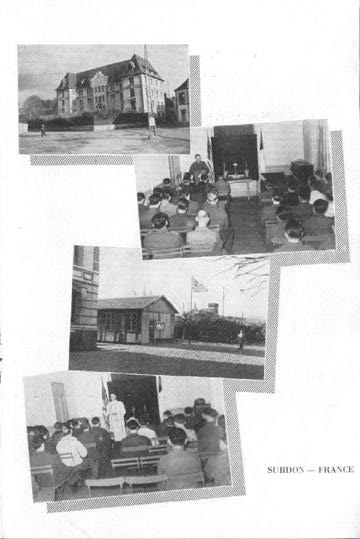
PAGE 29
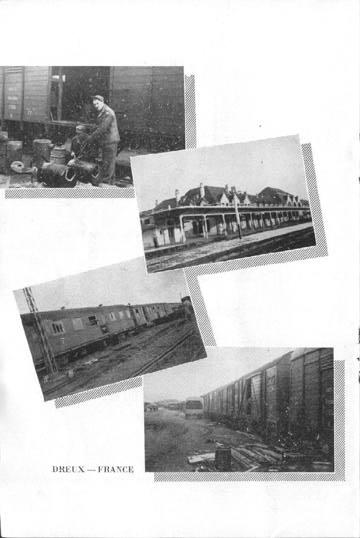
PAGE 30
OFFICERS
| State |
City |
Name |
Rank |
| CA |
Pasadena |
Larmer, George O.
Adjutant |
Capt |
| CA |
Sacramento |
Columbia, Charles M.
Mechanical Engineer |
1st Lt |
| DC |
Washington |
Van Vliet, Elvin W.
Administrative Officer |
1st Lt |
| ID |
Pocatello |
Joest, Earl O.
Master Mechanic |
Capt |
| IL |
Harvard |
Peters, Glenn W.
Asst Master Mechanic |
1st Lt |
| IL |
Sparta |
Tefertillar, George C.
Track Supervisor |
1st Lt |
| MD |
Relay |
McClooney, James E.
Chief Dispatcher |
1st Lt |
| MI |
Grand Rapids |
Alvord, James L.
Maintenance of Way
Supervisor |
Capt |
| MI |
Jackson |
Fedore, Herman J.
Rd Foreman of Engines |
1st Lt |
| MI |
Detroit |
Laur, William E.
Battalion Surgeon |
1st Lt |
| MO |
Kansas City |
Gresham, Doyle
Superintendent |
Lt Col |
| MO |
Pine Lawn |
Dyer, Vernon G.
Asst Maintenace of
Way Supervisor |
1st Lt |
| NE |
Boelus |
Jacobsen, John
B & B Supervisor |
1st Lt |
| NE |
Omaha |
Spain, Arthur J.
Railway Car Foreman |
1st Lt |
| NJ |
Maplewood |
Hildebrand, John C., Jr.
Administrative Officer
Company C |
2d Lt |
| NY |
New York |
Administrative Officer
Company B |
2d Lt |
| ND |
Minot |
Campbell, Albert E.
Enginehouse Foreman |
1st Lt |
| ND |
Steele |
Madsen, Harold S.
Asst Trainmaster |
1st Lt |
| OH |
Toledo |
Conner, Ralph W.
Asst Division Storekeeper |
WOJC |
| PA |
Philadelphia |
Lurie, Harold D.
Mess Officer |
1st Lt |
| PA |
Pittsburgh |
Kuntz, Edward V.
Battalion Dental Officer |
1st Lt |
| TX |
Brownwood |
Tillman, Thomas B.
Division Storekeeper |
Capt |
| UT |
Garfield |
Goff, Aubrey E.
Signal Supervisor |
1st Lt |
| VA |
Woodstock |
Edwards, Johathan
Chaplain |
Capt |
| WY |
Cheyenne |
West, Oscar E.
Asst Superintendent |
Major |
PAGES 31 and 32
HEADQUARTERS COMPANY
ENLISTED PERSONNEL
HHC ROSTER
PAGES 33 to 37
CHARLIE COMPANY
ENLISTED PERSONNEL
C Co ROSTER
PAGES 37 to 38
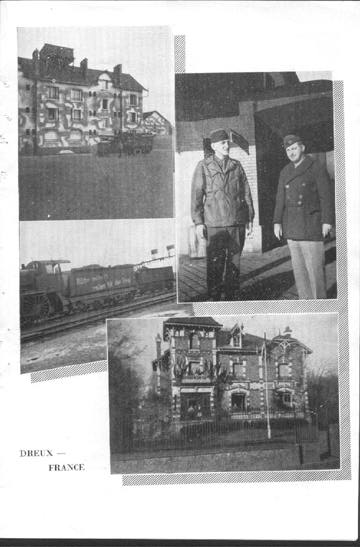
PAGE 39
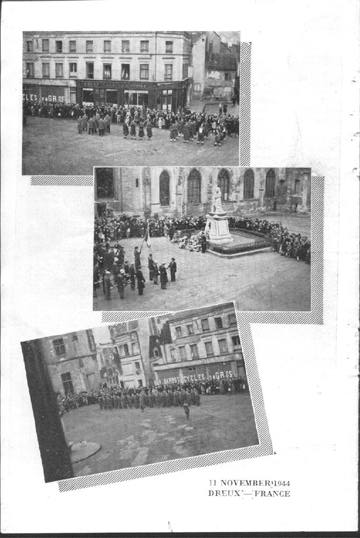
PAGE 40
CHARLIE COMPANY
ENLISTED PERSONNEL
C Co ROSTER
PAGES 41 to 48
ALPHA COMPANY
ENLISTED PERSONNEL
A Co ROSTER
PAGES 48 to 55
BRAVO COMPANY
ENLISTED PERSONNEL
B Co ROSTER
PAGES 55 to 59
STATISTICS
TRAIN MOVEMENTS - FRANCE, 11 SEPT 1944 TO 12 MARCH 1945
| EAST |
|
|
|
|
WEST |
|
|
|
|
No. Trains
|
Loads
|
Mtys
|
Net Tons |
|
No.
Train
|
Loads |
Mtys
|
Net Tons
|
| September 308 |
10,804
|
40
|
151,256
|
|
343
|
96
|
11,660
|
1,344
|
| October 651 |
24,725
|
2,168
|
311,062
|
|
650
|
1,026
|
23,990
|
12,314
|
| November 692 |
30,101
|
1,920
|
343,107
|
|
622
|
1,251
|
19,961
|
15,007
|
| December 491 |
22,508
|
2,010
|
277,216
|
|
504
|
761
|
17,698
|
9,126
|
| January 620 |
19,899
|
1,083
|
248,880
|
|
790
|
10,047 |
14,626
|
116,698
|
| February 696 |
21,511
|
2,391
|
264,108
|
|
912
|
13,878 |
14,147
|
162,390
|
| March-12th 393 |
15,521
|
1,821
|
201,773
|
|
500
|
6,955
|
11,778
|
97,370
|
| TOTAL 3,851 |
144,978 |
11,433 |
1,797,402
|
|
4,321
|
34,014 |
113,860 |
414,249
|
OPERATIONS
IN FRANCE |
|
|
|
|
|
|
|
|
TRAIN MOVEMENTS - GERMANY, 20 MARCH 1945 TO 15 JULY 1945
| EAST |
|
|
|
|
WEST |
|
|
|
| No. Trains |
Loads |
Mtys |
Net Tons |
|
No.
Trains
|
Loads |
Mtys |
Net Tons |
|
March-20th 486
|
12,586 |
888
|
176,204
|
|
413
|
2,229
|
8,857
|
31,206
|
| April
754 |
23,832 |
8,142
|
333,648
|
|
537
|
6,886
|
6,562
|
96,404
|
| May
633 |
18,883 |
2,357
|
264,362
|
|
632
|
17,423 |
12,326
|
243,922
|
| June
717 |
19,754 |
9,224
|
276,556
|
|
1,034
|
37,385 |
7,773
|
523,390
|
| July-15th 449 |
13,826 |
4,155
|
193,564
|
|
613
|
19,505 |
6,712
|
273,050
|
| TOTAL 3,039 |
88,881 |
24,766 |
1,244,334 |
|
3,229
|
83,428 |
42,230 |
1,167,992
|
OPERATIONS
IN GERMANY |
|
|
|
|
|
|
|
|
| TOTAL OPERATIONS |
No. Trains |
Loads |
Mtys |
Net Tons |
|
ETO
|
14,440 |
351,301 |
192,289 |
4,623,977 |
CAR, SHOP and ROUNDHOUSE
| CAPTURED ENEMY FREIGHT & |
|
No. CARS |
|
No. Engines |
Serviced |
| PASSENGER CARS STENCILED |
|
REPAIRED
|
|
and
|
Repaired |
|
|
|
|
|
|
|
|
|
|
France
|
Germany |
|
5,862
|
|
1,552
|
|
15,540
|
5,355 |
PAGE 60
SONG OF THE ARMY
TRANSPORTATION CORPS
KEEP IT MOVIN', KEEP IT MOVIN', THAT'S A JOB -
THE STUFF HAS GOTTA GET TO 'BUCKS',TO THE 'BOOTS',
THAT WE KNOW -
GOTTA FEED 'EM, HOWWE NEED'EM, BILL AND JOE,
THEY'LL BE MOPPIN' UP THE FOE.
WE LOAD THE SHIPS -
WE LOAD THE TRAINS -
SO THAT THE OTHER LADS CAN LOAD THE GUNS
AND PLANES.
WHEN YOU HEAR A MIGHTY ROAR,
IT'S THE TRANSPORTATION CORPS,
WE'VE GOTTA DELIVERTHE GOODS AND NOT A SINGLE
MAN COMPLAINS.
ALONG THE ROAD -
ALONG THE TRACK -
THE BRINY DEEP, WE GET 'EM THERE, WE BRING 'EM BACK.
DAY AND NIGHT WE'RE ON DUTY ON THE SEA AND SHORE;
ALWAYS READY TO JOIN THE FIGHT TO SAVE THE NATION -
THE ARMY TRANSPORTATION CORPS!
|
PAGE 61
Now on 26 August comes General Order No.44
From General Headquarters Military
Railway
Service assigning us to the First Military Railway
Service. And so - on to Marseilles
and Home?
PAGE 62
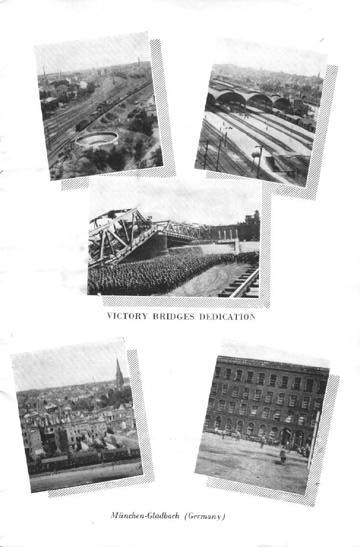
PAGE 63
RHEINISCHE DRUCKEREI G.M. B.H.
Munchen-Galdbach (Germany)
PAGE 64
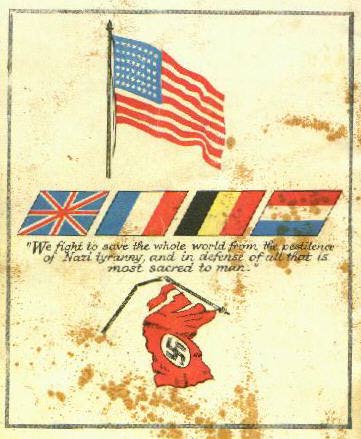
BACK COVER
 |
Home
Page
|











